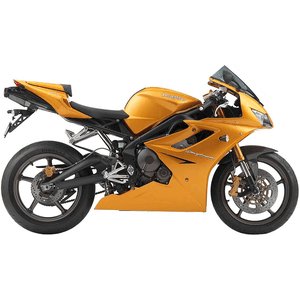Triumph Daytona 675 [2006–2008]: A Timeless Triple Threat in Supersport

Introduction
When Triumph unleashed the Daytona 675 in 2006, it didn’t just enter the supersport arena—it rewrote the rules. In a segment dominated by screaming inline-four engines, the Daytona 675 dared to be different with its inline-three powerplant. This wasn’t just a motorcycle; it was a statement. Over its 2006–2008 production run, the Daytona 675 racked up accolades, including MasterBike and Supertest titles, cementing its reputation as a benchmark for middleweight agility, torque-rich performance, and European flair. Riding this machine today, it’s clear why it remains a cult favorite: it’s a blend of character, innovation, and track-ready precision that still feels thrillingly modern.
Design & Aesthetics: Aggression Meets Elegance

The Daytona 675’s design is a masterclass in purposeful styling. From its shark-like front fairing to the underseat exhaust, every line screams performance. The twin-spar aluminum frame isn’t just lightweight (19.18 lbs / 8.7 kg, the lightest in its class) but also narrow, allowing riders to tuck in effortlessly. The 32.7-inch (830 mm) seat height feels sporty yet accessible, while the sculpted fuel tank offers excellent knee grip for aggressive cornering.
Special editions like the 2007 JPS Limited Edition (with its John Player Special livery) and the 2008 SE (Phantom Black with gold accents) added exclusivity. These models showcased Triumph’s attention to detail, from blacked-out engine covers to premium Pirelli Supercorsa Pro tires. Even today, the Daytona’s design language—clean, angular, and aerodynamic—stands out in a sea of generic sportbikes.
Engine & Performance: The Triple’s Triumph
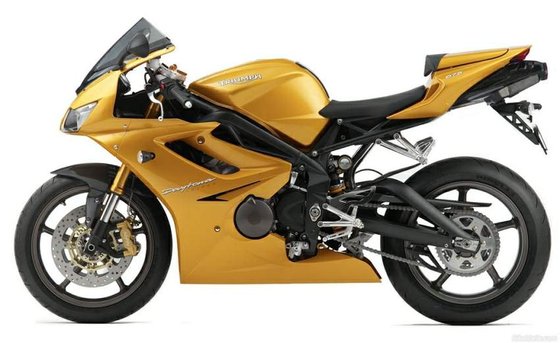
At the heart of the Daytona 675 lies its 675cc liquid-cooled inline-three engine, a masterpiece of engineering. With 123 hp (92 kW) at 12,500 RPM and 53 lb-ft (72 Nm) of torque at 11,750 RPM, this triple delivers a powerband that shames 600cc four-cylinders. Unlike peaky competitors, the Daytona pulls hard from 4,500 RPM, surging with a linear rush that’s usable on the street and explosive on the track.
The triple’s soundtrack is pure adrenaline—a metallic growl at low revs escalating to a howl as the tach approaches the 14,000 RPM redline. Fuel injection is flawlessly smooth, avoiding the jerky throttle response that plagued early-2000s sportbikes. However, the gearbox draws minor criticism: upshifts require deliberate effort, feeling notchier than the buttery transmissions of Japanese rivals. It’s a small quirk in an otherwise stellar package.
Performance Metrics:
- 0–60 mph (0–97 km/h): 3.2 seconds
- Top Speed: 154 mph (248 km/h)
- Fuel Economy: 40–45 mpg (5.9–5.2 L/100 km)
Handling & Ride: Razor-Sharp Precision
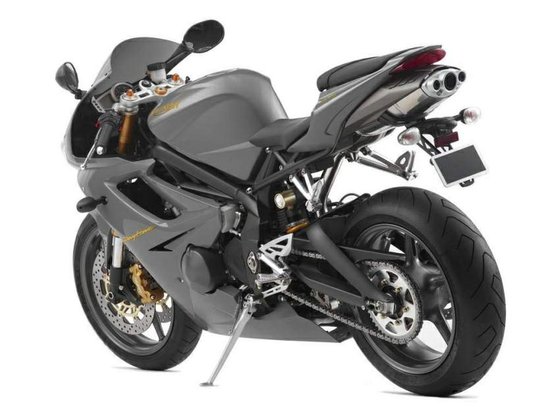
The Daytona’s chassis is where engineering brilliance shines. The aluminum frame and braced swingarm provide telepathic feedback, while fully adjustable 41mm Kayaba USD forks and a piggyback rear shock offer track-grade tuning. With a 54.9-inch (1,395 mm) wheelbase and a 23.9-degree rake, the 675 flicks into corners with minimal input, yet remains stable at triple-digit speeds.
Outfitting the bike with Pirelli Dragon Supercorsa Pro tires (120/70-17 front, 180/55-17 rear) was a bold move. These semi-slicks deliver racetrack grip in dry conditions, but their slick shoulders make wet rides treacherous. The Nissin radial brakes—dual 308mm discs up front—are equally track-focused, offering relentless stopping power with a two-finger squeeze.
Competition: How the Daytona Stacks Up
The 2006–2008 Daytona 675 faced fierce rivals, yet it carved a niche with its unique triple-cylinder charm:
- Yamaha YZF-R6: The R6’s high-revving 599cc inline-four (116 hp) demanded aggressive riding to access its powerband. While it edged out the Daytona on track lap times, it lacked low-end torque for street usability.
- Honda CBR600RR: A balanced all-rounder with Honda’s legendary reliability, but its muted exhaust note and clinical feel couldn’t match the Triumph’s personality.
- Ducati 749: The Daytona’s closest European rival shared its passion for cornering, but the Ducati’s V-twin vibes and maintenance costs made the Triumph a pragmatic choice.
The Daytona’s 53 lb-ft of torque—20% more than 600cc rivals—gave it a decisive edge in real-world riding. It was a bike that thrilled on backroads and commutes, not just racetracks.
Maintenance: Keeping the 675 at Its Best

Owning a Daytona 675 is a joy, but proactive maintenance ensures longevity:
- Oil Changes: Use 10W-40 or 10W-50 synthetic oil (3.1L with filter). MOTOPARTS.store offers kits with OEM-grade filters and crush washers.
- Valve Adjustments: Check every 12,000 miles (19,300 km). Intake valves: 0.10–0.20 mm, exhaust: 0.325–0.375 mm (cold).
- Chain Care: The O-ring chain requires regular cleaning and lubrication. Upgrade to a DID VX3 chain for durability.
- Brake Upgrades: Swap stock pads for EBC HH sintered pads for improved bite and fade resistance.
- Suspension Tuning: Stiff stock settings suit track use; soften compression damping for street comfort.
Pro Tip: The stock exhaust is heavy. A lightweight SC-Project slip-on saves 8 lbs (3.6 kg) and amplifies the triple’s roar.
Conclusion: A Modern Classic
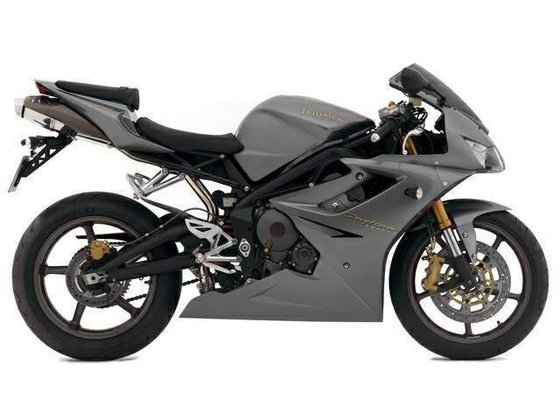
The Triumph Daytona 675 isn’t just a motorcycle—it’s an experience. Its combination of soulful engine character, razor-sharp handling, and head-turning design ensures it remains relevant years after its debut. Whether you’re carving canyons, hunting apexes, or simply savoring the triple’s soundtrack, the Daytona delivers a ride that’s as engaging today as it was in 2006. For owners looking to enhance their machine, MOTOPARTS.store offers everything from performance upgrades to OEM replacements, ensuring your 675 continues to defy the ordinary.
Ride hard. Ride smart. Keep the triple roaring.







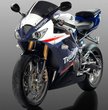
Specifications sheet
| Engine | |
|---|---|
| Stroke: | Four-stroke |
| Max power: | 92 kW | 123.0 hp |
| Max torque: | 72 Nm |
| Fuel system: | Multipoint sequential electronic fuel injection with forced air induction |
| Lubrication: | Wet sump |
| Max power @: | 12500 rpm |
| Displacement: | 675 ccm |
| Max torque @: | 11750 rpm |
| Configuration: | Inline |
| Cooling system: | Liquid-cooled |
| Compression ratio: | 12.65:1 |
| Number of cylinders: | 3 |
| Dimensions | |
|---|---|
| Wheelbase: | 1395 mm (54.9 in) |
| Dry weight: | 166 |
| Wet weight: | 185 |
| Seat height: | 830 mm (32.7 in) |
| Overall width: | 710 mm (27.9 in) |
| Overall height: | 1105 mm (43.5 in) |
| Overall length: | 2020 mm (79.5 in) |
| Ground clearance: | 165 mm (6.5 in) |
| Fuel tank capacity: | 17.5 L (4.6 US gal) |
| Drivetrain | |
|---|---|
| Final drive: | chain |
| Chain length: | 116 |
| Transmission: | 6-speed |
| Rear sprocket: | 47 |
| Front sprocket: | 16 |
| Maintenance | |
|---|---|
| Rear tire: | 180/55-17 |
| Engine oil: | 10W40 |
| Front tire: | 120/70-17 |
| Brake fluid: | DOT 4 |
| Spark plugs: | NGK CR9EK |
| Spark plug gap: | 0.7 |
| Coolant capacity: | 2.4 |
| Forks oil capacity: | 0.99 |
| Engine oil capacity: | 3.6 |
| Valve clearance (intake, cold): | 0.10–0.20 mm |
| Valve clearance (exhaust, cold): | 0.325–0.375 mm |
| Recommended tire pressure (rear): | 2.5 bar (36 psi) |
| Recommended tire pressure (front): | 2.4 bar (35 psi) |
| Additional Features | |
|---|---|
| Exhaust: | Stainless steel 3-into-1 system with underseat silencer |
| Instruments: | LCD multi-functional display with gear position indicator, lap timer, and programmable shift lights |
| Standard tires: | Pirelli Dragon Supercorsa Pro |
| Chassis and Suspension | |
|---|---|
| Frame: | Aluminum beam twin spar |
| Rear brakes: | Single 220 mm disc, 1-piston caliper (ABS on some models) |
| Front brakes: | 2 x 308 mm discs, 4-piston calipers (ABS on some models) |
| Rear suspension: | Monoshock with piggyback reservoir, adjustable preload, rebound, and compression damping |
| Steering damper: | Included |
| Front suspension: | 41mm USD forks, adjustable preload, rebound, and compression damping |



